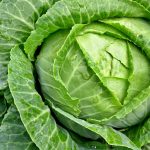 Considering that we buy cabbages in heads, it’s hardly surprising that the word cabbage literally means swollen head: the name derives from the Old French caboce, which in turn may have developed from a compound formed from the Latin caput, meaning head, and the Old French boce, meaning a swelling. Words related to cabbage therefore include other descendants of the Latin caput such as decapitate (meaning to remove the head], chapter (a section of a book with its own “heading”), and precipitate (literally meaning to fall head first). In English, the word cabbage first appeared in the mid fifteenth century; prior to this, cabbage was called cole, a word still represented in cauliflower and coleslaw.
Considering that we buy cabbages in heads, it’s hardly surprising that the word cabbage literally means swollen head: the name derives from the Old French caboce, which in turn may have developed from a compound formed from the Latin caput, meaning head, and the Old French boce, meaning a swelling. Words related to cabbage therefore include other descendants of the Latin caput such as decapitate (meaning to remove the head], chapter (a section of a book with its own “heading”), and precipitate (literally meaning to fall head first). In English, the word cabbage first appeared in the mid fifteenth century; prior to this, cabbage was called cole, a word still represented in cauliflower and coleslaw.
Cabbage is a diverse vegetable that comes in many different varieties. The most commonly consumed types are white and red cabbage, spring greens, Savoy cabbage, turnip tops, and kale. Additionally, Brussels sprouts, broccoli, and cauliflower are part of the same family as cabbage. Cabbage varieties are further categorized based on their growing season, with winter-grown types available for consumption in the spring and early summer, and those planted in the spring to be eaten during the late summer, autumn, and winter. This range of options makes cabbage a versatile and popular vegetable that can be enjoyed in various dishes throughout the year.
